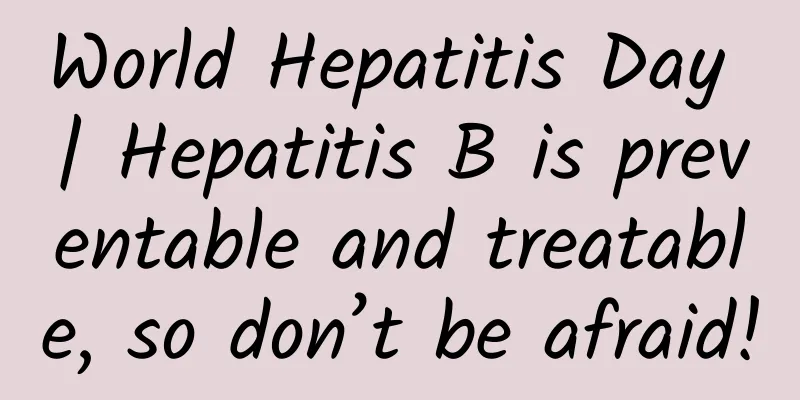World Hepatitis Day | Hepatitis B is preventable and treatable, so don’t be afraid!

|
If there is any infectious disease that poses the greatest threat to human health, it is probably hepatitis B virus (HBV). According to the World Health Organization, about one-third of the world's population has been infected with HBV, and 15% to 25% of these people will die from hepatitis-related diseases. my country is a country with a high incidence of hepatitis B. In the 1990s, according to statistics from the Chinese Center for Disease Control and Prevention, 60% of the population had been infected with hepatitis B. In March this year, the "2020 National Notifiable Infectious Diseases Epidemic Overview" released by the National Health Commission showed that in 2020, there were 902,476 cases of hepatitis B in my country, with an incidence rate of 64.2861/100,000, while the incidence rate of the new coronavirus pneumonia that is currently raging around the world is 6.2023/100,000. Unlike hepatitis A and E, hepatitis B is not transmitted through the digestive tract, so you will not be infected with hepatitis B by eating with a hepatitis B carrier, hugging or shaking hands, etc. The main ways of transmission of hepatitis B are mother-to-child transmission, blood transmission, and body fluid transmission. But why is the incidence of hepatitis B virus higher? The main reason is that most people do not know that they carry the hepatitis B virus, so they often do not protect themselves from it, resulting in its continuous spread. So, how can we determine whether we are infected with the hepatitis B virus in a timely manner? This has to mention hepatitis B screening. Hepatitis B screening "two pairs and a half" In the hepatitis B screening, three antigens are generally examined - surface antigen, e antigen and core antigen; the corresponding immune system will have three antibodies: surface antibody, e antibody and core antibody. Since antibodies will eliminate the corresponding antigens, in general, antigens and corresponding antibodies will not be positive at the same time. Let's talk specifically about the meaning of each antigen and antibody: Surface antigen (HBsAg)/antibody (anti-HBs): Surface antigen indicates whether there is hepatitis B virus in the blood. A positive result indicates that there is virus in the blood, while a negative result indicates that there is no virus in the blood. Surface antibody indicates whether the human body has resistance to the virus. A positive result indicates that the immune system has resistance to hepatitis B virus, while a negative result indicates that the immune system has no immunity to hepatitis B virus. e antigen (HBeAg)/antibody (anti-HBe): e antigen indicates whether the virus is replicating. A positive result indicates that the virus is actively replicating, while a negative result indicates that the virus is not actively replicating. e antibody can inhibit the replication of hepatitis B virus. Core antigen/antibody (anti-HBc): Core antigen is also evidence of the existence of the virus, but core antigen is difficult to detect in the blood, so only core antibody is tested instead. This is the "half". Hepatitis B vaccine "makes a great contribution" The hepatitis B virus is actually not scary. It is preventable like the HIV virus. Because its transmission method is the same as AIDS, the prevention of hepatitis B also requires cutting off the three major transmission routes, namely: blood transmission, mother-to-child transmission, and sexual transmission. Even better, the hepatitis B virus can be blocked by vaccination. Speaking of hepatitis B vaccine, we have to mention Dr. Baruch Samuel Blumberg, the winner of the 1976 Nobel Prize in Physiology or Medicine. In 1963, Dr. Blumberg accidentally discovered while screening blood samples that the serum of a hemophilia patient could react with the serum of an Australian Aboriginal, so he called this mysterious substance in the latter's serum "Australia antigen" (abbreviated as "Australia antigen"). After that, in the research of hepatitis B vaccine, Blumberg and his colleagues proposed a new idea of using Australian antigen instead of the whole virus as vaccine. After years of extensive research and testing, they finally succeeded in purifying hepatitis B surface antigen from blood and preparing hepatitis B vaccine, which can provide more than 90% immunity to hepatitis B. Large sample trials conducted thereafter confirmed that the vaccine can reduce the hepatitis B infection rate by 75%. In 1981, the hepatitis B vaccine was approved for marketing by the US Food and Drug Administration (FDA). This is the first commercial hepatitis B vaccine in human history and a revolutionary breakthrough in the fight against hepatitis B. my country began to vaccinate against hepatitis B virus in 1993. The vaccine has saved tens of millions of children from becoming hepatitis B virus carriers and has gradually reduced the number of liver disease patients in my country. July 28 is Dr. Bloomberg's birthday. To commemorate the discoverer of the Australian antigen, the World Health Organization decided in May 2010 to change the annual World Hepatitis Day from May 19 to July 28 starting from 2011. Active treatment to "beat it" For acute hepatitis B infection, if the amount of infected virus is low and the body's own resistance is high, the body can automatically clear most of the virus and heal itself. Therefore, for some patients who receive antiviral and liver protection treatment in the early stage of acute hepatitis, the recovery rate is relatively high. The more commonly used drugs in clinical practice include hepatitis B immunoglobulin, antiviral drugs (interferon-α, nucleoside drugs), immunomodulators, anti-inflammatory liver protection drugs, anti-fibrosis drugs, etc. During treatment, there are a few points to remind you: 1. Antiviral drugs should be used in accordance with the doctor's and pharmacist's advice, with full course of treatment and full dosage. Do not change or stop the drug at will. 2. Do not blindly use more medicines. Many medicines are detoxified by the liver. Blindly increasing the amount of therapeutic drugs is not only not conducive to the treatment of the disease, but also increases the burden on the liver. 3. Be sure to quit drinking. Hepatitis patients must not drink alcohol, as alcohol is harmful to the liver and has no benefits. 4. Check liver function regularly and adjust treatment plan in time according to the level and condition of your liver function under the advice of your doctor. 5. Pay attention to rest and nutrition, and avoid overwork. Adequate rest and nutritional guarantee are the main treatment methods for patients with liver disease. Only on the basis of ensuring rest and nutrition can the drug work better. Author: Mao Changqing, Chief Pharmacist, Jinshan Branch, Shanghai Sixth People's Hospital Review expert: Shen Weihua, deputy director and pharmacist of Jinshan Branch of Shanghai Sixth People's Hospital Wang Baoxin, deputy director and pharmacist of the Pharmacy Department of Peking University First Hospital |
<<: Why is the tea tree mushroom bitter? What are the methods for making tea tree mushroom soup?
>>: Latest report! The virus strain in Nanjing is the Delta strain
Recommend
Can breastfeeding kill tooth nerves?
Many people are prone to getting inflamed during ...
How to eat golden passion fruit (wash and eat directly or add honey to make passion fruit juice)
...
Contraindications of transvaginal ultrasound
Some gynecological diseases can only be detected ...
28 days of menstrual cycle, when is the ovulation date
For women who are preparing to get pregnant, they...
How many days after menstruation is it normal to ovulate
Many young people use menstruation to estimate th...
How much does McDonald's Alexander Wang Black Gold Bucket cost? What does McDonald's Alexander Wang Black Gold Bucket contain?
McDonald's is a popular fast food restaurant....
What can I eat during the confinement period?
Some mothers feel restricted in many aspects duri...
Can vaginal flatulence be restored after a normal delivery?
Natural childbirth seems extremely scary for most...
Do you know what vulvar leukoplakia is?
Nowadays, many people have heard of vulvar leukop...
The origin of matcha and the originator of latte art actually dates back to the Song Dynasty?
I believe many people have seen the tea-drinking ...
Is the giant salamander a fish? How to raise it?
The scientific name of the giant salamander is th...
Drinking beer during menstruation
When it comes to beer, most people have drunk it,...
What to eat for women with indigestion
Dyspepsia is the most common multifunctional gast...
What are the biggest symptoms of menopause in women?
When talking about menopause, the first thing peo...
Taking Diane 35 can cause breast pain
Diane 35 is an ovulation-suppressing drug. Some p...









